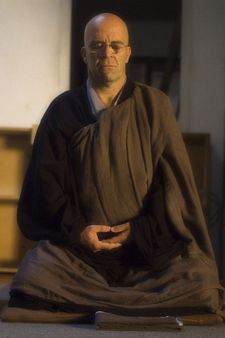“If someone asks what true Zen is,
it is not necessary to open your mouth to explain.
Show him all the aspects of your zazen posture.
Then the spring wind will blow
and open the wonderful plum blossom”.
Daichi-Sokei (1290-1366)
It is important to understand the different aspects of Zen posture, so as not to force the body into a rigidly immobile position that goes against its natural physiology. The posture is balanced, relaxed and vertical.
The position of the pelvis is crucial. Sit in the middle of the zafu (round cushion with a thickness suited to the sitter’s flexibility), upon the ischial bone structure, so that the pelvis is stabilized by the knees’ contact with the floor. The legs are in the lotus or half-lotus position. The correct position of the pelvis and the right thickness of the zafu enables the spine to be directed skyward without creating harmful tensions in the upper back or between vertebrae and allows the head to be naturally straight. The shoulders, ribcage and abdomen are relaxed in order to allow a free and easy breathing. The eyes are half-closed, and lowered to the floor at a 45° angle.
The wrists are placed on the upper thighs. The fingers of the left hand are placed on top of the fingers of the right, palms upward; above this, the thumbs touch with a firm but light contact, forming a continuous line. The edges of the hands touch the abdomen.
During zazen, vigilant attention should be paid to each detail, as well as to the breathing. This way, the mind is brought back to the body and unity is achieved. Thoughts are no longer strung along one after the other. They appear, because it is their nature to do so, but if attention is maintained focussed to the posture, they disappear without a trace. Naturally and unconsciously, the personal will ceases to act and seek a goal. Only the present moment remains.
It is impossible to see your own posture and easy to be deluded about your own practice. Therefore, it is highly recommended that you don’t practice alone and that you receive advice from an experienced practitioner in a dojo (“hall of the Way”).

